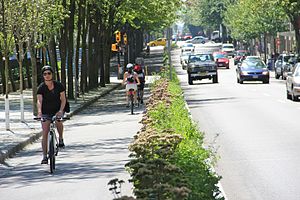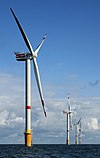Sustainable energy/ja: Difference between revisions
Created page with "thumb|alt=屋根の下のずんぐりした金属製の箱に差し込まれた車の列の写真|いくつかの国と欧州連合は、すべての新車を[[:en:zero-emissions vehicle|ゼロエミッション車とする日付を決定している。]]" |
Created page with "===規制=== 環境規制は、1970年代からより持続可能なエネルギー利用を促進するために用いられてきた。一部の政府は、石炭火力発電所の段階的廃止や新規化石燃料探査の終了時期を決定している。政府は、新車にゼロエミッションを義務付けたり、新築の建物の暖房にガスではなく電力を使用するよう求めたりで..." Tags: Mobile edit Mobile web edit |
||
| Line 294: | Line 294: | ||
</div> | </div> | ||
===規制=== | |||
=== | 環境規制は、1970年代からより持続可能なエネルギー利用を促進するために用いられてきた。一部の政府は、[[:en:Coal phase-out|石炭火力発電所の段階的廃止]]や[[:en:fossil fuel exploration|新規化石燃料探査]]の終了時期を決定している。政府は、新車にゼロエミッションを義務付けたり、新築の建物の暖房にガスではなく電力を使用するよう求めたりできる。いくつかの国における[[:en:Renewable portfolio standard|再生可能エネルギーポートフォリオ基準]]は、電力会社に対し、再生可能エネルギー源から生成する電力の割合を増やすことを義務付けている。 | ||
[[ | 政府は、長距離送電線、スマートグリッド、水素パイプラインなどのインフラ開発を主導することで、エネルギーシステムの変革を加速できる。運輸においては、適切なインフラとインセンティブにより、移動をより効率的にし、自動車への依存度を減らすことが可能である。スプロール現象を抑制する[[都市計画]]は、地域交通と建物のエネルギー使用量を削減しつつ、生活の質を向上させる。政府資金による研究、調達、およびインセンティブ政策は、太陽光やリチウム電池などのクリーンエネルギー技術の開発と成熟に歴史的に不可欠であった。IEAによる2050年までのネットゼロエミッションエネルギーシステムのシナリオでは、幅広い新しい技術を実証段階に移行させ、導入を促進するために、公的資金が迅速に動員される。 | ||
[[File:MicrocityCarSharingHangzhou.jpg|thumb|alt=屋根の下のずんぐりした金属製の箱に差し込まれた車の列の写真|いくつかの国と欧州連合は、すべての新車を[[:en:zero-emissions vehicle|ゼロエミッション車]]とする日付を決定している。]] | [[File:MicrocityCarSharingHangzhou.jpg|thumb|alt=屋根の下のずんぐりした金属製の箱に差し込まれた車の列の写真|いくつかの国と欧州連合は、すべての新車を[[:en:zero-emissions vehicle|ゼロエミッション車]]とする日付を決定している。]] | ||
Revision as of 14:28, 17 July 2025
| Part of a series on |
| Sustainable energy |
|---|
 |
エネルギーは、「将来の世代が自らのニーズを満たす能力を損なうことなく、現在のニーズを満たす」場合に持続可能である。持続可能なエネルギーの定義は、通常、環境、経済、社会への影響を考慮している。これらの影響は、温室効果ガス排出や大気汚染からエネルギー貧困や有害廃棄物にまで及ぶ。風力、水力、太陽光、地熱などの再生可能エネルギー源は環境に損害を与える可能性があるが、一般的に化石燃料源よりもはるかに持続可能である。
持続可能なエネルギーにおける非再生可能エネルギー源の役割は議論の的である。原子力発電は炭素汚染や大気汚染を発生させないが、放射性廃棄物、核拡散のリスク、事故のリスクといった欠点がある。石炭から天然ガスへの転換は、気候変動への影響が低いなど環境上の利点があるが、より持続可能な選択肢への転換を遅らせる可能性がある。炭素回収・貯留は、発電所から二酸化炭素(CO2)排出物を除去するために組み込むことができるが、この技術は高価であり、ほとんど実施されていないのが現状である。
化石燃料は世界のエネルギー消費量の85%を占め、エネルギーシステムは世界の温室効果ガス排出量の76%を担っている。発展途上国では約7億9000万人が電力へのアクセスを欠き、26億人が木材や木炭といった汚染燃料に調理を依存している。バイオマス燃料での調理と化石燃料による汚染は、毎年推定700万人の死者を出している。地球温暖化を2℃に抑えるためには、エネルギーの生産、配給、貯蔵、消費の変革が不可欠である。クリーンな電力への普遍的なアクセスは、気候、人間の健康、そして発展途上国の経済に大きな利益をもたらしうる。
気候変動緩和策として、地球温暖化を2℃に抑えるための道筋が提案されている。これには、石炭火力発電所の段階的廃止、省エネルギー、風力や太陽光などのクリーンな電源からの発電量増加、輸送や建物の暖房における化石燃料から電力への転換が含まれる。一部の再生可能エネルギー源からの発電量は、風が吹く時間や太陽が照る時間によって変動する。そのため、再生可能エネルギーへの転換には、送電網のアップグレード(エネルギー貯蔵の追加など)が必要になる場合がある。電化が困難な一部のプロセスでは、低排出エネルギー源から生産される水素燃料を使用できる。国際エネルギー機関が提案する2050年までのネットゼロ排出量達成計画では、排出量削減の約35%が2023年現在開発中の技術に依存している。
2019年には、世界の電力における風力と太陽光の市場シェアは8.5%にまで成長し、コストは下がり続けている。気候変動に関する政府間パネル(IPCC)は、地球温暖化を1.5℃に抑えるためには、2016年から2035年の間に毎年世界のGDPの2.5%をエネルギーシステムに投資する必要があると推定している。各国政府は、新しいクリーンエネルギー技術の研究、開発、実証に資金を提供できる。また、電化と持続可能な輸送のためのインフラを整備することも可能である。さらに、政府は炭素価格制度、再生可能エネルギーポートフォリオ基準、化石燃料補助金の段階的廃止といった政策によって、クリーンエネルギーの導入を促進できる。これらの政策はエネルギー安全保障も高める可能性がある。
定義と背景
潘基文国連事務総長
定義
国連のブルントラント委員会は、1987年の報告書『われらの共通の未来』の中で、エネルギーが重要な要素である持続可能な開発の概念について述べた。同委員会は、持続可能な開発を「将来の世代が自らのニーズを満たす能力を損なうことなく、現在のニーズを満たす」ことと定義した。この持続可能な開発の記述は、その後、持続可能なエネルギーに関する多くの定義や説明の中で引用されている。
グローバル規模で持続可能性の概念がエネルギーにどのように適用されるかについては、普遍的に受け入れられた解釈は存在しない。持続可能なエネルギーの実用的な定義は、環境、経済、社会といった持続可能性の多様な側面を包含している。歴史的に見ると、持続可能なエネルギー開発の概念は、排出量とエネルギー安全保障に焦点を当ててきた。1990年代初頭以降、この概念はより広範な社会経済的問題を含むように拡大している。
持続可能性の環境側面には、温室効果ガス排出量、生物多様性と生態系への影響、有害廃棄物と有毒排出物、そして非再生可能資源の枯渇が含まれます。環境負荷の低いエネルギー源は、時に「グリーンエネルギー」または「クリーンエネルギー」と呼ばれます。持続可能性の経済側面は、経済発展、効率的なエネルギー利用、そして各国が十分なエネルギーに常にアクセスできることを保証するエネルギー安全保障を網羅している。社会問題には、すべての人々が手頃な価格で信頼できるエネルギーを利用できること、労働者の権利、そして土地の権利が含まれる。
環境への影響


現在のエネルギーシステムは、気候変動、大気汚染、生物多様性の損失、環境への毒素放出、水不足など、多くの環境問題の一因となっている。2019年現在、世界のエネルギー需要の85%は化石燃料の燃焼によって賄われている。2018年現在、エネルギーの生産と消費は、年間人間活動による温室効果ガス排出量の76%を占めている。2015年の気候変動に関する国際合意であるパリ協定は、地球温暖化を2℃を十分に下回るように、できれば1.5℃に抑えることを目指しており、この目標達成には、排出量をできるだけ早く削減し、今世紀半ばまでに実質ゼロにする必要がある。
化石燃料とバイオマスの燃焼は、大気汚染の主要な原因であり、年間推定700万人が死亡しており、特に低所得国および中所得国で最大の疾患負担が見られる。発電所、車両、工場における化石燃料の燃焼は、大気中の酸素と結合して酸性雨を引き起こす排出物の主な発生源である。大気汚染は、非感染性疾患による死因の第2位となっている。世界の人口の推定99%が、世界保健機関が推奨する制限値を超える大気汚染レベルの中で生活している。
薪、動物の糞、石炭、灯油といった汚染燃料での調理は、屋内外の大気汚染のほぼすべての原因となっており、年間推定160万から380万人の死亡を引き起こしている。健康への影響は、調理を担当する可能性が高い女性や幼い子供に集中している。
燃焼による副産物以外にも、環境への影響は及ぶ。海上での石油流出は海洋生物に害を与え、有毒な排出物を放出する火災を引き起こす可能性がある。世界の水使用量の約10%はエネルギー生産、主に火力発電所での冷却に費やされている。乾燥地域では、これは水不足の一因となっている。バイオエネルギー生産、石炭採掘と加工、石油抽出も大量の水を必要とする。燃焼目的での木材やその他の可燃性物質の過剰な採取は、砂漠化を含む深刻な局所的環境被害を引き起こす可能性がある。
持続可能な開発目標

既存および将来のエネルギー需要を持続可能な方法で満たすことは、経済成長を維持し、生活水準の向上を可能にしつつ、気候変動を抑制するという世界的な目標にとって極めて重要な課題である。特に電力のような信頼性があり手頃な価格のエネルギーは、医療、教育、経済発展に不可欠です。2020年現在、発展途上国では7億9000万人が電力にアクセスできず、約26億人が調理のために汚染燃料の燃焼に依存している。
後発開発途上国におけるエネルギーアクセスの改善と、エネルギーのクリーン化は、気候変動対策からジェンダー平等まで多岐にわたる国連の2030年持続可能な開発目標のほとんどを達成するための鍵となる。持続可能な開発目標7は、「すべての人々に手ごろで信頼でき、持続可能かつ近代的なエネルギーへのアクセス」を求めており、これには2030年までの普遍的な電力へのアクセスとクリーンな調理設備へのアクセスが含まれている。
省エネルギー

エネルギー効率、つまり同じ財やサービスを提供するためにより少ないエネルギーを使用すること、あるいはより少ない財で同等のサービスを提供することは、多くの持続可能なエネルギー戦略の要石です。国際エネルギー機関(IEA)は、エネルギー効率を高めることで、パリ協定の目標達成に必要な温室効果ガス排出量削減の40%を達成できると推定している。
エネルギーは、家電製品、車両、産業プロセス、建物の技術効率を高めることで節約できる。もう一つのアプローチは、より良い建築設計やリサイクルなどを通じて、生産に多くのエネルギーを必要とする材料の使用を減らすことである。出張で飛行機を利用する代わりにビデオ会議を利用したり、都市内の移動を車ではなく自転車、徒歩、公共交通機関にすることで、エネルギーを節約することも可能である。政府の効率改善政策には、建築基準、性能基準、炭素価格制度、そして交通手段の変化を促すエネルギー効率の良いインフラの開発などが含まれる。
世界の経済におけるエネルギー強度(GDP1単位あたりに消費されるエネルギー量)は、経済生産のエネルギー効率の目安となる。2010年、世界のエネルギー強度はGDP1米ドルあたり5.6メガジュール(1.6kWh)だった。国連の目標では、2010年から2030年の間にエネルギー強度を毎年2.6%削減することを求めている。しかし近年、この目標は達成されていない。例えば、2017年から2018年にかけて、エネルギー強度はわずか1.1%しか減少しなかった。
効率改善はしばしば、消費者が節約したお金をよりエネルギー集約的な財やサービスの購入に充てるという、ジェボンズのパラドックスにつながる。例えば、輸送や建物における最近の技術的効率改善は、より大型の車両や住宅を選択するといった消費者行動の傾向によって、大部分が相殺されてしまっている。
持続可能なエネルギー源 =
再生可能エネルギー源

再生可能エネルギー源は、エネルギー安全保障を強化し、化石燃料よりもはるかに少ない温室効果ガスを排出するため、持続可能なエネルギーに不可欠である。ただし、再生可能エネルギープロジェクトも、生態学的に価値の高い地域がバイオエネルギー生産や風力・太陽光発電所に転換される際に、生物多様性へのリスクなど、重大な持続可能性の懸念を引き起こすことがある。
水力発電は再生可能電力の最大の供給源であり、太陽光と風力エネルギーは急速に成長している。ほとんどの国で、太陽光発電と陸上風力発電は新規発電設備の中で最も安価な形態だ。現在電力にアクセスできない7億7000万人のうち半数以上にとって、太陽光発電ミニグリッドのような分散型再生可能エネルギーは、2030年までに電力を供給する最も安価な方法となる可能性が高い。国連の2030年目標には、世界のエネルギー供給における再生可能エネルギーの割合を大幅に増加させることが含まれている。
国際エネルギー機関 (IEA) によると、風力や太陽光発電といった再生可能エネルギー源は今や一般的な電力源であり、世界の新規発電設備投資の70%を占めている。IEAは、今後3年以内に再生可能エネルギーが石炭を抜き、世界の電力供給における主要なエネルギー源になると予測している。
太陽光

太陽は地球の主要なエネルギー源であり、多くの地域でクリーンで豊富に入手可能な資源である。2019年には、太陽光発電は主に太陽光パネル(太陽電池を基盤とする)を通じて世界の電力の約3%を供給した。太陽光発電は、2027年までに世界最大の設備容量を持つ電力源になると予想されている。これらのパネルは建物の屋根に設置されるか、大規模な太陽光発電所に設置される。太陽電池のコストは急速に低下しており、世界中の設備容量の力強い成長を牽引している。新しい太陽光発電所からの電力コストは、既存の石炭火力発電所からの電力と競争力があり、多くの場所ではそれよりも安価である。将来のエネルギー使用に関する様々な予測では、太陽光発電が持続可能なエネルギー構成における主要な発電源の一つとして挙げられている。
ソーラーパネルのほとんどの部品は簡単にリサイクルできるが、規制がないと必ずしも行われているわけではない。パネルには通常重金属が含まれているため、埋立地に廃棄されると環境リスクをもたらす。ソーラーパネルがその製造に使用されたのと同じ量のエネルギーを生産するのに要する期間は2年未満である。材料が採掘ではなくリサイクルされる場合、必要なエネルギーはさらに少なくなる。
集光型太陽熱発電では、鏡の集光によって太陽光線を集中させ、流体を加熱する。結果として生じる蒸気から、熱機関を使って電力が生成される。集光型太陽熱発電は、熱の一部を貯蔵して必要な時に電力を生成できるようにすることで、ディスパッチ可能な発電をサポートできる。電力生産に加えて、太陽エネルギーはより直接的に利用されており、太陽熱暖房システムは給湯、建物の暖房、乾燥、淡水化に利用されている。
風力発電

風は何千年にもわたり、産業プロセス、水ポンプ、帆船に機械的エネルギーを供給することで、開発の重要な推進力となってきた。現代の風力タービンは発電に使用され、2019年には世界の電力の約6%を供給した。陸上風力発電所からの電力は、既存の石炭火力発電所よりも安価なことが多く、天然ガスや原子力とも競争力がある。風力タービンは洋上にも設置でき、そこでは陸上よりも風が安定していて強いが、建設費と維持費は高くなる。
陸上風力発電所は、しばしば自然豊かな地域や農村部に建設されるため、景観に視覚的な影響を与える。風力タービンとの衝突によりコウモリや、程度は低いものの鳥が死亡することもあるが、これらの影響は窓や送電線といった他のインフラによるものよりも小さい。タービンから発生する騒音やちらつきのある光は不快感を引き起こし、人口密集地近くでの建設を制限する可能性がある。原子力発電所や化石燃料発電所とは対照的に、風力発電は水を消費しない。風力発電所自体が生み出すエネルギーと比較して、風力タービンの建設に必要なエネルギーは少ない。
水力発電

水力発電所は、流れる水のエネルギーを電気に変換する。2020年、水力発電は世界の電力の17%を供給したが、これは20世紀半ばから後半にかけての約20%という最高値からは減少している。
従来の水力発電では、ダムの背後に貯水池が作られる。従来の水力発電所は、非常に柔軟で調整可能な電力供給を提供する。これらは、需要のピークに対応したり、風力や太陽光の利用が少ない時に補完したりするために、風力発電や太陽光発電と組み合わせることができる。
貯水池型の施設と比較して、流れ込み式水力発電は一般的に環境への影響が少ない。しかし、その発電能力は河川流量に依存し、これは日々の天候や季節によって変動する可能性がある。貯水池は、治水や柔軟な電力出力に利用される水量の調整機能を提供するとともに、干ばつ時の飲料水供給や灌漑に対する安全性も提供する。
水力発電は、エネルギー生産量あたりの温室効果ガス排出量が最も少ないエネルギー源の一つだが、その排出レベルはプロジェクトによって大きく異なる。最も排出量が多いのは、熱帯地域の大規模ダムで発生する傾向がある。これらの排出は、貯水池の湛水で水没した生物学的物質が分解され、二酸化炭素とメタンを放出する際に発生する。森林伐採と気候変動は、水力発電ダムからのエネルギー生成を減少させる可能性がある。場所によっては、大規模ダムは住民を強制移住させたり、深刻な地域環境被害を引き起こしたりする可能性があり、ダムの決壊は周辺住民を危険にさらす可能性がある。
地熱

地熱エネルギーは、地下深部の熱を利用して発電したり、水や建物を温めたりすることで生成される。地熱エネルギーの利用は、高い温度、熱流量、そして透過性(流体が岩石を通過できる能力)の組み合わせが必要な、熱抽出が経済的に可能な地域に集中している。地下の貯水池で生成された蒸気から電力が作られる。2020年、地熱エネルギーは世界のエネルギー消費量の1%未満を供給した。
地熱エネルギーは、周辺の高温地域からの熱の絶え間ない補充と、天然に存在する同位体の放射性崩壊によって熱エネルギーが常に補給されるため、再生可能資源である。平均して、地熱発電による温室効果ガス排出量は、石炭火力発電の5%未満に過ぎない。地熱エネルギーは地震を誘発するリスクがあり、水質汚染を避けるための効果的な保護が必要であり、捕捉可能な有毒な排出物を放出する可能性がある。
バイオエネルギー


バイオマスは、植物や動物に由来する再生可能な有機物質である。熱や電力を生成するために燃焼させることも、車両の燃料として使用できるバイオ燃料(バイオディーゼルやエタノールなど)に変換することもできる。
バイオエネルギーの気候への影響は、バイオマスの原料がどこから来て、どのように栽培されるかによって大きく異なる。例えば、エネルギーのために木材を燃やすと二酸化炭素が放出されるが、伐採された木が適切に管理された森林で新しい木に置き換えられれば、新しい木が成長するにつれて空気中の二酸化炭素を吸収するため、これらの排出は大幅に相殺されうる。しかし、バイオエネルギー作物の確立と栽培は、自然の生態系を変位させ、土壌を劣化させ、水資源や合成肥料を消費する可能性がある。
熱帯地域で伝統的な暖房や調理に使われる木材の約3分の1は、持続不可能な方法で伐採されている。バイオエネルギーの原料は通常、収穫、乾燥、輸送にかなりの量のエネルギーを必要とし、これらのプロセスでのエネルギー使用は温室効果ガスを排出する可能性がある。場合によっては、土地利用の変化、栽培、加工の影響により、バイオエネルギーの方が化石燃料を使用するよりも全体の炭素排出量が多くなることがある。
バイオマス栽培のために農地を使用すると、食料生産に利用できる土地が減少する可能性がある。米国では、自動車用ガソリンの約10%がトウモロコシ由来のエタノールに置き換えられているが、これはかなりの収穫量を必要とする。マレーシアとインドネシアでは、バイオディーゼル用のパーム油を生産するために森林を伐採した結果、深刻な社会的および環境的影響が生じている。これらの森林は重要な炭素吸収源であり、多様な種の生息地であるためだ。光合成は太陽光のエネルギーのごく一部しか捕捉しないため、一定量のバイオエネルギーを生産するには、他の再生可能エネルギー源と比較して大量の土地が必要となる。
第二世代バイオ燃料は、非食用の植物や廃棄物から生産されるため、食料生産との競合を減らすことができる。しかし、保護地域とのトレードオフや地域の大気汚染など、他の負の影響をもたらす可能性がある。比較的持続可能なバイオマス源としては、藻類、廃棄物、そして食料生産には不適な土壌で栽培される作物などが挙げられる。
炭素回収・貯留技術は、バイオエネルギー発電所からの排出を回収するために使用できる。このプロセスはバイオエネルギー炭素回収・貯留(BECCS)として知られ、大気からの正味の二酸化炭素除去をもたらす可能性がある。しかし、BECCSもまた、バイオマス材料の栽培、収穫、輸送方法によっては、正味でプラスの排出量となる可能性がある。一部の気候変動緩和経路で記述されている規模でのBECCSの展開には、大量の農地転換が必要となるだろう。
海洋エネルギー
海洋エネルギーは、エネルギー市場において最も小さいシェアを占めている。これには、海洋温度差発電(OTEC)、実用化が進む潮力発電、そして開発の初期段階にある波力発電が含まれる。フランスと韓国にある2つの潮汐堰システムが、世界の生産量の90%を占める。単一の海洋エネルギー装置が環境に与えるリスクは小さいものの、より大型の装置が与える影響については、まだ十分に解明されていない。
非再生可能エネルギー源
化石燃料の転換と緩和策
石炭から天然ガスへの転換は、持続可能性の観点から利点がある。生産されるエネルギー単位あたりで比較すると、天然ガスのライフサイクル温室効果ガス排出量は風力や原子力の約40倍だが、石炭よりははるかに少ない。発電に利用する場合、天然ガスの燃焼による排出量は石炭の約半分であり、熱生産に利用する場合は石炭の約3分の2となる。また、天然ガスの燃焼は石炭よりも大気汚染物質の排出が少ない。しかし、天然ガス自体が強力な温室効果ガスであり、採掘や輸送中の漏出は、石炭からの転換による利点を帳消しにしてしまう可能性がある。メタン漏出を抑制する技術は広く利用可能だが、常に使用されているわけではない。
石炭から天然ガスへの転換は、短期的には排出量を削減するため、気候変動緩和に貢献する。しかし、長期的には正味ゼロ排出への道筋を提供するものではない。天然ガスインフラの開発は、炭素のロックインや座礁資産のリスクを伴う。これは、新たな化石燃料インフラが数十年にわたる炭素排出を約束するか、利益を上げる前に償却されなければならない状況を指す。
化石燃料およびバイオマス発電所の温室効果ガス排出量は、炭素回収・貯留(CCS)によって大幅に削減できる。ほとんどの研究では、CCSが発電所からの二酸化炭素(CO2)排出量の85〜90%を回収できるという前提に基づいている。たとえ石炭火力発電所から排出されるCO2の90%が回収されたとしても、回収されなかった排出量は、原子力、太陽光、風力エネルギーが生産する電力単位あたりの排出量よりもはるかに多い。 CCSを使用する石炭火力発電所は効率が低いため、より多くの石炭を必要とし、その結果、石炭の採掘や輸送に伴う汚染が増加する。CCSは、エネルギー部門における排出量削減のための最も高価な方法の一つである。この技術の導入は非常に限定的で、2024年現在、CCSはわずか5つの発電所と39のその他の施設でしか使用されていない。
原子力発電

原子力発電は、1950年代からベースロード電力の低炭素源として利用されてきた。30カ国以上にある原子力発電所は、世界の電力の約10%を供給している。2019年現在、原子力は全低炭素エネルギーの4分の1以上を生産しており、水力発電に次ぐ第2位の供給源となっている。
原子力のライフサイクル温室効果ガス排出量(ウランの採掘・加工を含む)は、再生可能エネルギー源からの排出量と同程度である。原子力は、主要な再生可能エネルギーと比較して、生産されるエネルギー単位あたりの土地使用量が少ない。さらに、原子力は局所的な大気汚染を引き起こさない。核分裂発電所の燃料となるウラン鉱石は非再生可能資源であるが、数百年から数千年分の供給を賄える量が存在する。しかし、現在の技術では経済的に採掘可能なウラン資源は限られており、拡大期にはウラン生産が追いつかない可能性がある。意欲的な目標に合致する気候変動緩和経路では、通常、原子力による電力供給の増加が見込まれている。
原子力発電が持続可能であるか否かについては、核廃棄物、核兵器拡散、事故に関する懸念から、議論が続いている。放射性核廃棄物は数千年にわたる管理が必要となる。 しかし、生産されるエネルギー単位あたりで比較すると、原子力発電が原因となる事故や汚染関連の死亡者数は、化石燃料よりもはるかに少ない。また、原子力の過去の死亡率は再生可能エネルギー源と同程度である。原子力エネルギーに対する世論の反対は、原子力発電所の導入を政治的に困難にすることがしばしばある。
新規原子力発電所の建設期間とコスト削減は長年の目標となっているが、コストは依然として高く、期間も長期にわたる。在来型プラントの欠点を克服するため、様々な新しい形態の原子力エネルギーが開発中である。高速増殖炉は核廃棄物の再処理が可能であり、地層処分が必要な廃棄物の量を大幅に削減できるが、大規模な商業ベースでの導入には至っていない。トリウム(ウランではなく)をベースとする原子力発電は、ウラン供給が少ない国々にとってエネルギー安全保障を高める可能性がある。小型モジュール炉は、現在の大型炉に比べていくつかの利点を持つとされる。より迅速な建設が可能であり、モジュール化により経験曲線効果によるコスト削減が見込まれる。また、従来の発電所よりも安全性が高いと考えられている。
複数の国が核融合炉の開発を試みており、これは少量の廃棄物を生成し、爆発のリスクもない。核融合は研究室レベルでは前進しているものの、商業化、そして規模拡大には数十年かかるため、気候変動緩和のための2050年ネットゼロ目標には貢献できないだろう。
エネルギーシステムの変革

地球のエネルギーシステムの脱炭素化
地球温暖化を2℃未満に抑えるために必要な排出削減には、エネルギーの生産、配給、貯蔵、消費の方法におけるシステム全体の変革が求められる。社会が一方のエネルギー形態を他方に置き換えるには、エネルギーシステム内の複数の技術や行動を変える必要がある。例えば、自動車のエネルギー源を石油から太陽光発電に移行させるには、太陽光発電の生成、太陽光パネルの出力変動に対応するための送電網の改修、または可変充電器の導入と全体的な需要の増加、電気自動車の導入、電気自動車充電設備および修理工場のネットワークが必要となる。
多くの気候変動緩和経路では、低炭素エネルギーシステムの3つの主要な側面が想定されている:
- 電力生産における低排出エネルギー源の利用
- 電化 – すなわち、化石燃料を直接燃焼させる代わりに電力の使用を増加させること
- エネルギー効率改善策の加速的な導入
航空、海運、製鉄など、一部のエネルギー集約型技術やプロセスは電化が困難である。これらの分野からの排出量を削減するための選択肢はいくつか存在する。バイオ燃料や合成カーボンニュートラル燃料は、化石燃料を燃焼するように設計された多くの車両を動かすことができるが、バイオ燃料は必要な量を持続可能に生産することができず、合成燃料は現在非常に高価である。一部の用途においては、電化に代わる最も有望な選択肢は、持続可能な方法で生産された水素燃料をベースとしたシステムの開発である。
世界のエネルギーシステムの完全な脱炭素化は、数十年を要すると見込まれており、その大部分は既存技術で達成可能である。しかし、IEAが2050年までのネットゼロ排出達成のために提案するシナリオでは、排出量削減の約35%が、2023年時点でまだ開発段階にある技術に依存している。比較的新しい技術には、電池やカーボンニュートラル燃料を生成するプロセスが含まれる。新しい技術の開発には、研究開発、実証、そして展開によるコスト削減が必要となる。
ゼロカーボンエネルギーシステムへの移行は、人間の健康に強い共同便益をもたらすだろう。世界保健機関(WHO)は、地球温暖化を1.5℃に抑える努力が、大気汚染の削減のみで毎年数百万人の命を救う可能性があると推定している。適切な計画と管理があれば、気候目標と整合する形で、2030年までに普遍的な電力へのアクセスとクリーンな調理を提供する道筋が存在する。歴史的に見れば、いくつかの国は石炭の使用を通じて急速な経済的利益を得てきた。しかし、適切な国際投資と知識移転があれば、多くの貧しい国や地域には、再生可能エネルギーに基づいたエネルギーシステムを開発することで、化石燃料への依存から「リープフロッグ」する機会がまだ残されている。
可変性エネルギー源の統合

風力や太陽光のような可変性再生可能エネルギー源から信頼性の高い電力を供給するためには、電力システムに柔軟性が必要となる。ほとんどの送電網は、石炭火力発電所のような間欠性のないエネルギー源のために構築されてきた。太陽光や風力エネルギーが送電網に大量に統合されるにつれて、電力供給が需要と一致するようにエネルギーシステムに変更を加える必要がある。2019年には、これらの電源が世界の電力の8.5%を生成し、そのシェアは急速に伸びている。
電力システムの柔軟性を高める方法は多岐にわたる。多くの地域で、風力発電と太陽光発電は日ごと、季節ごとに互いを補完し合っています。太陽光エネルギーの生産量が少ない夜間や冬期には、風力発電量が増加する傾向がある 。長距離送電線で異なる地理的地域を結ぶことで、変動性をさらに相殺することができる。エネルギー需要管理やスマートグリッドの活用により、エネルギー需要を時間的にシフトさせ、可変性エネルギー生産が最大となる時間帯に合わせることが可能である。 系統蓄電があれば、余剰に生産されたエネルギーを必要な時に放出できます。さらに、セクターカップリング(電力部門と熱・モビリティ部門をパワー・トゥ・ヒートシステムや電気自動車で連携させること)によっても柔軟性を高めることができる。
風力発電や太陽光発電の設備容量を過剰に建設することは、悪天候時でも十分な電力が生産されることを保証するのに役立つ。しかし、最適な天候の場合、余剰電力が利用または貯蔵できない場合、発電量を抑制しなければならないことがある。最終的な需要と供給のミスマッチは、水力発電、バイオエネルギー、天然ガスといった調整可能なエネルギー源によって補うことができるであろう。
エネルギー貯蔵
エネルギー貯蔵は、間欠性のある再生可能エネルギーに対する障壁を克服するのに役立ち、持続可能なエネルギーシステムにおいて重要な側面である。最も一般的に使用され、利用可能な貯蔵方法は揚水発電であり、これは大きな高低差と水へのアクセスが必要となる。バッテリー、特にリチウムイオンバッテリーも広く導入されている。バッテリーは通常、短期間の電力を貯蔵する。季節を通して十分な容量を持つ技術の研究が進行中である。
米国の公益事業規模バッテリーのコストは2015年以降約70%下落しましたが、バッテリーのコストと低いエネルギー密度は、季節間のエネルギー生産変動を調整するために必要な非常に大規模なエネルギー貯蔵には実用的ではないことを意味する。数ヶ月間の使用が可能な揚水式水力貯蔵やパワー・トゥ・ガス(電力をガスに変換し、再び電力に戻す)は一部の地域で導入されている。国際エネルギー機関(IEA)によると、世界全体のバッテリー貯蔵容量は、コストの低下とクリーンインフラへの投資増加に牽引され、2021年から2030年の間に約15倍に増加すると予想されている。
電化

エネルギーシステム全体と比較して、電力部門では排出量をはるかに速く削減できる。2019年時点で、世界の電力の37%は低炭素電源(再生可能エネルギーと原子力エネルギー)から生産されている。残りの電力供給は、主に石炭を燃料とする化石燃料によって賄われている。温室効果ガス排出量を削減する最も簡単で迅速な方法の1つは、石炭火力発電所を段階的に廃止し、再生可能エネルギーによる発電を増やすことである。
気候変動緩和の経路では、広範な電化、すなわち建物の暖房や輸送において、化石燃料の直接燃焼の代わりに電力を使用することが想定されている。意欲的な気候変動政策が実施されれば、2020年の20%から、2050年までに電力として消費されるエネルギーの割合が2倍になると見込まれている。
光発電設備のように、村落のために十分な電力を発電し蓄電する、再生可能エネルギーに基づいたオフグリッドシステムやミニグリッドシステムは、重要な解決策となる。信頼性の高い電力へのアクセスが拡大すれば、現在開発途上国で一般的な灯油ランプやディーゼル発電機の使用が減少するであろう。
再生可能電力の生成と貯蔵のためのインフラには、バッテリー用のコバルトやリチウム、ソーラーパネル用の銅といった鉱物や金属が必要である。製品のライフサイクルが適切に設計されていれば、リサイクルによってこの需要の一部を満たすことができる。しかし、ネットゼロ排出を達成するには、17種類の金属と鉱物の採掘を大幅に増加させる必要がある。 これらの商品の市場は、ごく少数の国や企業が支配していることがあり、地政学的な懸念を引き起こしている。例えば、世界のコバルトのほとんどはコンゴ民主共和国で採掘されている。この国は政治的に不安定な地域であり、採掘は人権リスクと関連していることがしばしばある。より多様な地理的調達は、より柔軟で強靭なサプライチェーンを確保することにつながるであろう。
水素
水素ガスは、温室効果ガス排出量を削減する可能性のある燃料として広く議論されている。これには、より安価でエネルギー効率の高い緩和代替手段が限られている部門や用途に供給するために、水素をクリーンに大量生産する必要がある。これらの用途には、重工業や長距離輸送が含まれる。
水素は、燃料電池のエネルギー源として電力生産に、あるいは燃焼によって熱を生成するために展開されうる。水素が燃料電池で消費される際、使用時点での唯一の排出物は水蒸気である。水素の燃焼は、有害な窒素酸化物の熱的生成につながる可能性がある。水素の全体的なライフサイクル排出量は、その生産方法に依存する。世界の現在の水素供給のほぼ全ては、化石燃料から生み出されている。
水素を生産する主な方法は水蒸気メタン改質であり、メタン(天然ガスの主成分)と水蒸気の間の化学反応によって水素が生産される。このプロセスで1トンの水素を生産すると、6.6〜9.3トンの二酸化炭素が排出される。二酸化炭素回収・貯留(CCS)によってこれらの排出量の大部分を除去できるものの、天然ガスからの水素の全体的なカーボンフットプリントを評価することは、一部には天然ガス自体の生産で発生する排出(放出および漏洩メタンを含む)のため、2021年現在、困難である。
電解は、電気が持続可能な方法で生成された場合に限り、水分子を分解して持続可能な水素を生成するために使用できる。しかし、この電気分解プロセスは現在、CCSなしでメタンから水素を生成するよりも高価であり、エネルギー変換効率は本質的に低い。水素は変動性再生可能エネルギーの余剰があるときに生産し、貯蔵して熱を生成したり、電力を再生成したりするのに使用できる。さらにグリーンアンモニアやグリーンメタノールなどの液体燃料に変換することも可能である。水素電解装置の革新は、電力からの大規模な水素生産をより費用競争力のあるものにする可能性がある。
水素燃料は、鉄鋼、セメント、ガラス、化学物質の工業生産に必要な高熱を生成できるため、製鋼用の電気アーク炉などの他の技術とともに、産業の脱炭素化に貢献する。製鋼において、水素はクリーンな燃料として機能すると同時に、石炭由来のコークスに代わる低炭素の触媒としても機能しうる。輸送の脱炭素化に用いられる水素は、海運、航空、そして重貨物車両である程度の規模で最大の用途が見出される可能性が高い。軽自動車の場合、水素は他の代替燃料車両に大きく後れを取っており、特にバッテリー式電気自動車の普及率と比較すると、将来的には重要な役割を果たさない可能性がある。
燃料としての水素の欠点としては、水素の爆発性、他の燃料と比較して体積が大きいこと、および配管を脆くする傾向があることによる、貯蔵および流通の高コストが挙げられる。
エネルギー利用技術
Transport

Transport accounts for 14% of global greenhouse gas emissions, but there are multiple ways to make transport more sustainable. Public transport typically emits fewer greenhouse gases per passenger than personal vehicles, since trains and buses can carry many more passengers at once. Short-distance flights can be replaced by high-speed rail, which is more efficient, especially when electrified.
The energy efficiency of cars has increased over time, but shifting to electric vehicles is an important further step towards decarbonising transport and reducing air pollution. A large proportion of traffic-related air pollution consists of particulate matter from road dust and the wearing-down of tyres and brake pads. Substantially reducing pollution from these non-tailpipe sources cannot be achieved by electrification; it requires measures such as making vehicles lighter and driving them less. Light-duty cars in particular are a prime candidate for decarbonization using battery technology. 25% of the world's CO
2 emissions still originate from the transportation sector.
Long-distance freight transport and aviation are difficult sectors to electrify with current technologies, mostly because of the weight of batteries needed for long-distance travel, battery recharging times, and limited battery lifespans. Where available, freight transport by ship and rail is generally more sustainable than by air and by road. Hydrogen vehicles may be an option for larger vehicles such as lorries. Many of the techniques needed to lower emissions from shipping and aviation are still early in their development, with ammonia (produced from hydrogen) a promising candidate for shipping fuel. Aviation biofuel may be one of the better uses of bioenergy if emissions are captured and stored during manufacture of the fuel.
Buildings
Over one-third of energy use is in buildings and their construction. To heat buildings, alternatives to burning fossil fuels and biomass include electrification through heat pumps or electric heaters, geothermal energy, central solar heating, reuse of waste heat, and seasonal thermal energy storage. Heat pumps provide both heat and air conditioning through a single appliance. The IEA estimates heat pumps could provide over 90% of space and water heating requirements globally.

Cooking

Industry
Over one-third of energy use is by industry. Most of that energy is deployed in thermal processes: generating heat, drying, and refrigeration. The share of renewable energy in industry was 14.5% in 2017—mostly low-temperature heat supplied by bioenergy and electricity. The most energy-intensive activities in industry have the lowest shares of renewable energy, as they face limitations in generating heat at temperatures over 200 °C (390 °F).
For some industrial processes, commercialisation of technologies that have not yet been built or operated at full scale will be needed to eliminate greenhouse gas emissions. Steelmaking, for instance, is difficult to electrify because it traditionally uses coke, which is derived from coal, both to create very high-temperature heat and as an ingredient in the steel itself. The production of plastic, cement, and fertilisers also requires significant amounts of energy, with limited possibilities available to decarbonise. A switch to a circular economy would make industry more sustainable as it involves recycling more and thereby using less energy compared to investing energy to mine and refine new raw materials.
Government policies
International Energy Agency (2021)
Well-designed government policies that promote energy system transformation can lower greenhouse gas emissions and improve air quality simultaneously, and in many cases can also increase energy security and lessen the financial burden of using energy.
規制
環境規制は、1970年代からより持続可能なエネルギー利用を促進するために用いられてきた。一部の政府は、石炭火力発電所の段階的廃止や新規化石燃料探査の終了時期を決定している。政府は、新車にゼロエミッションを義務付けたり、新築の建物の暖房にガスではなく電力を使用するよう求めたりできる。いくつかの国における再生可能エネルギーポートフォリオ基準は、電力会社に対し、再生可能エネルギー源から生成する電力の割合を増やすことを義務付けている。 政府は、長距離送電線、スマートグリッド、水素パイプラインなどのインフラ開発を主導することで、エネルギーシステムの変革を加速できる。運輸においては、適切なインフラとインセンティブにより、移動をより効率的にし、自動車への依存度を減らすことが可能である。スプロール現象を抑制する都市計画は、地域交通と建物のエネルギー使用量を削減しつつ、生活の質を向上させる。政府資金による研究、調達、およびインセンティブ政策は、太陽光やリチウム電池などのクリーンエネルギー技術の開発と成熟に歴史的に不可欠であった。IEAによる2050年までのネットゼロエミッションエネルギーシステムのシナリオでは、幅広い新しい技術を実証段階に移行させ、導入を促進するために、公的資金が迅速に動員される。

炭素価格
炭素価格設定(CO
2排出量に対する税など)は、産業界や消費者が排出量を削減するためのインセンティブを与えつつ、その方法を選択できるようにする。例えば、低排出エネルギー源への転換、エネルギー効率の改善、またはエネルギー集約型製品やサービスの利用削減などが挙げられる。炭素価格設定は、一部の強い政治的反発に遭遇しているが、エネルギーに特化した政策は政治的に安全である傾向がある。ほとんどの研究は、地球温暖化を1.5℃に制限するためには、炭素価格設定が厳格なエネルギー特化型政策によって補完される必要があることを示している。
2019年時点では、ほとんどの地域における炭素価格は、パリ協定の目標を達成するには低すぎる。炭素税は、他の税金を下げる、あるいは低所得世帯が高いエネルギーコストを賄うのを助けるために使用できる歳入源を提供する。EUや英国などの一部の政府は、炭素国境調整措置の利用を検討している。これらは、国内の炭素価格の対象となる産業の競争力を確保するため、気候政策が厳しくない国からの輸入品に関税を課すものである。
ペース
2020年時点で開始されている政策改革の規模とペースは、パリ協定の気候目標を達成するために必要な水準には遠く及ばない。国内政策に加えて、イノベーションを加速し、貧しい国々が完全なエネルギーアクセスへの持続可能な道を確立するのを支援するためには、より一層の国際協力が必要である。
各国は、雇用創出のために再生可能エネルギーを支援する場合がある。国際労働機関の推定によると、地球温暖化を2°Cに制限する取り組みは、経済のほとんどの部門で正味の雇用創出をもたらすという。具体的には、2030年までに再生可能電力の生成、建物のエネルギー効率改善、電気自動車への移行といった分野で2,400万人の新規雇用が創出されると予測されている。一方で、鉱業や化石燃料などの部門では600万人の雇用が失われる見込みである。政府は、化石燃料産業に依存する労働者や地域が代替の経済的機会を確実に得られるよう、公正な移行を保証することで、持続可能なエネルギーへの移行を政治的・社会的に実行可能なものにできる。
財政

イノベーションと投資のために十分な資金を調達することは、エネルギー転換の前提条件である。IPCCは、地球温暖化を1.5℃に制限するためには、2016年から2035年の間に毎年2.4兆米ドルがエネルギーシステムに投資される必要があると推定している。ほとんどの調査では、これらの費用は世界のGDPの2.5%に相当するが、経済的および健康上の利益と比較すれば小さいと予測している。低炭素エネルギー技術とエネルギー効率への年間平均投資額は、2015年と比較して2050年までに6倍になる必要がある。資金不足は、後発開発途上国において特に深刻であり、これらの国は民間セクターにとって魅力的ではない。
気候変動に関する国際連合枠組条約は、2016年の気候変動対策資金の総額を6,810億ドルと推定している。この大半は、再生可能エネルギー導入への民間セクター投資、持続可能な交通への公共セクター投資、およびエネルギー効率化への民間セクター投資である。パリ協定には、先進国から途上国に対し、気候変動緩和と気候変動適応のために年間1,000億ドルを追加で拠出するという公約が含まれている。この目標は達成されておらず、進捗状況の測定は不明確な会計規則によって妨げられている。化学、肥料、セラミックス、鉄鋼、非鉄金属などのエネルギー集約型産業が研究開発に多額の投資を行えば、産業におけるその利用は、全使用エネルギーの5%から20%に達する可能性がある。
化石燃料への資金供給と補助金は、エネルギー転換における大きな障壁である。これらを廃止することで、世界の炭素排出量を28%削減し、大気汚染による死者を46%削減できる可能性がある。クリーンエネルギーへの資金供給は、COVID-19パンデミックによる影響をほとんど受けておらず、パンデミック関連の経済刺激策はグリーンリカバリーの可能性をもたらしている。
外部リンク
| この記事は、クリエイティブ・コモンズ・表示・継承ライセンス3.0のもとで公表されたウィキペディアの項目Sustainable energy(14 July 2025, at 05:46編集記事参照)を翻訳して二次利用しています。 |
- Pages using multiple image with auto scaled images
- Sustainable energy
- Climate change mitigation
- Climate change policy
- Emissions reduction
- Energy economics
- Environmental impact of the energy industry
- Sustainable development
- Sustainability
- Sustainability by subject
- Sustainability and environmental management
- Energy








